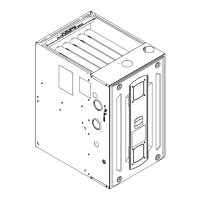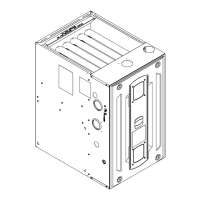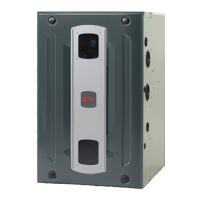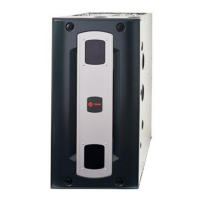36
S9V2-VS-SVX001-1C-EN
BONDING OF PVC
Note: It is recommended that the first joints from the Furnace be
connected and sealed with high temperature RTV. This will
enable the pipes to be removed later without cutting.
Be sure to properly support these joints.
Commercially available solvent cement for PVC must be used to join
PVC pipe fittings. Follow instructions on container carefully.
Pipe and Fitting – ASTM D1785, D2466, D2661, & D2665
PVC Primer and Solvent Cement – ASTM D2564
Procedure for Cementing Joints – Ref ASTM D2855
1. Cut pipe square, remove ragged edges and burrs. Chamfer end of
pipe, then clean fitting socket and pipe joint area of all dirt,
grease, moisture or chips.
2. After checking pipe and socket for proper fit, wipe socket and pipe
with cleaner-primer. Apply a liberal coat of primer to inside
surface of socket and outside of pipe.
DO NOT ALLOW PRIMER TO DRY BEFORE APPLYING CEMENT.
3. Apply a thin coat of cement evenly in the socket. Quickly apply a
heavy coat of cement to the pipe end and insert pipe into fitting
with a slight twisting movement until it bottoms out.
4. Hold the pipe in the fitting for 30 seconds to prevent tapered
socket from pushing the pipe out of the fitting.
5. Wipe all excess cement from the joint with a rag. Allow 15
minutes before handling. Cure time varies according to fit,
temperature and humidity.
Connection of the pipe and collar of the combustion air inlet should
just be a friction fit. It is recommended that the inlet air joint be sealed
with RTV type sealant to allow the joint to be separated for possible
future service. The inlet and vent pipes must be properly supported
throughout the entire length.
Note: Follow venting instructions carefully when using PVC cement.
Important: All joints must be water tight. Flue condensate is
somewhat acidic, and leaks can cause equipment
damage.
Seal INLET AIR PIPE
with RTV sealant
APPROVED VENT PIPE MATERIALS
PVC VENT FITTING MATERIAL
These fittings are available from your Gas Furnace Distributors.
ANSI/UL 1738 APPROVED VENT PIPE MATERIAL
ASTM STANDARD PIPE TYPE ALLOWABLE TEMPERATURE °F MARKING
N/A N/A
158 UL 1738
PVC
ASTM STANDARD PIPE TYPE ALLOWABLE TEMPERATURE °F MARKING
F891
CELLULAR CORE
(a)
158 ASTM F891
D2665 DWV PIPE 158 ASTM D2665
D1785
SCH 40, 80, 120
158 ASTM 1785
D2241 SDR SERIES 158 ASTM D2241
CPVC
ASTM STANDARD PIPE TYPE ALLOWABLE TEMPERATURE °F MARKING
D2846 CPVC 41 212 ASTM D2846
F441
SCH 40, 80
212 ASTM F441
F442 SDR SERIES 212 ASTM F442
ABS
ASTM STANDARD PIPE TYPE ALLOWABLE TEMPERATURE °F MARKING
D2661 SCH 40 DWV 180 ASTM D2661
F628
SCH 40 DWV CELLULAR CORE
(a)
180 ASTM F628
PolyPro® by DuraVent, Z-Dens by Novaflex Group, Innoflue® by Centrotherm, System 1738 by IPEX, ECCO™ polypropylene venting system,
and PolyFlue™ polypropylene venting systems.
ASTM STANDARD PIPE TYPE ALLOWABLE TEMPERATURE °F MARKING
N/A N/A
230 ULC-S636
(a)
Beginning March 1, 2024, PVC Cellular Core and ABS Cellular Core vent materials are not approved.
FFuurrnnaaccee GGeenneerraall IInnssttaallllaattiioonn

